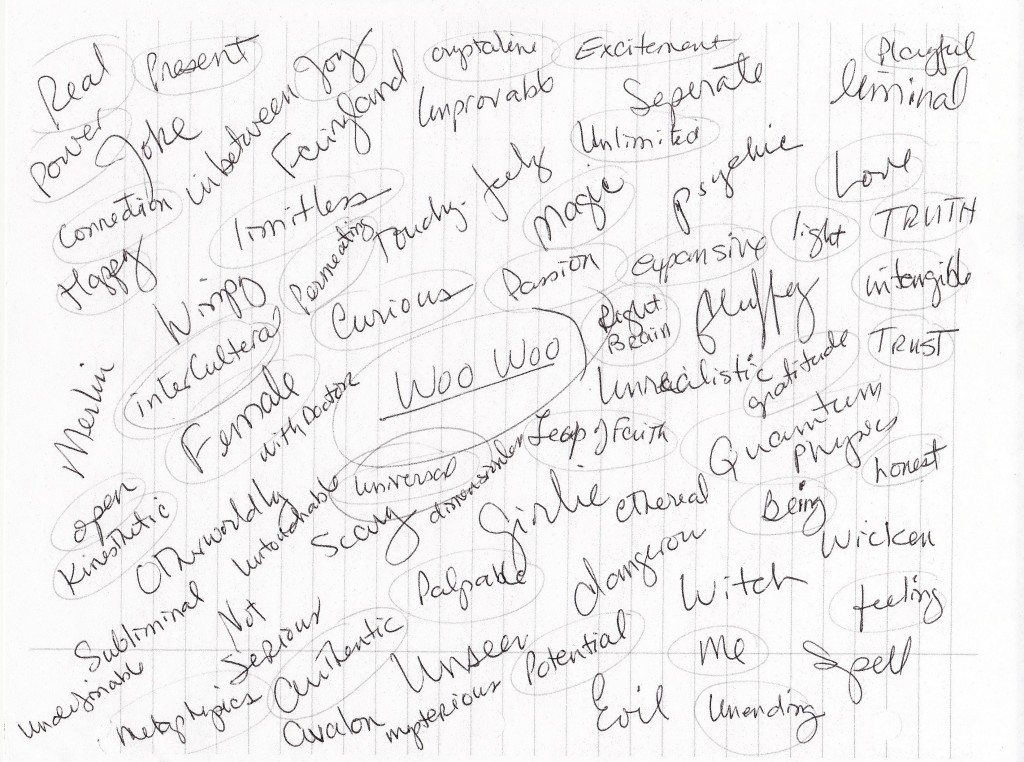This post was triggered by a post written by my friend and soul-sister, Jenny Bones. It has become one of those topics that started burning a hole in my pocket to the point that I couldn’t get to anything else until I took it out.
Jenny’s post What’s Wrong With a Little Woo? (at her new website, an exciting change of direction for her) hit a nerve with me.
I am, among other things, an Organization Development (OD) consultant. And even though that sounds mighty Proper and Official, people in OD (and HR and Training and Development, and all the associated tracks) are sometimes looked down upon by The Corporate World as being, well, woo-woo. Touchy-feely. We deal with feelings. And soft skills. (Among other things.) Sometimes the work we do isn’t perceived as being “closest to the dollar” (or anywhere near it, except as an expense). Dealing with and overcoming this perception is not an unusual topic at professional meetings and trainings.
So I wasn’t surprised when I went to a workshop last fall called Become an Inspiring Speaker (which was FABULOUS) that there was a lot of self-deprecating humor among participants and presenters about being perceived as being woo-woo. What did surprise me was that when someone would ask, “What does that mean?” or challenge the use of the term, people would kind of hem and haw and change the subject.
“Woo-woo” is one of those terms that everyone kind of knows the definition of.
“Woo-woo” is one of those slang terms that everyone kind of knows the definition of, but here are a couple of official definitions (from the Internet, which is never wrong):
Wiktionary.org says: “It has been suggested that “woo woo” is intended to imitate the eerie background music of sci-fi/horror films and television shows, however the exact origin is uncertain.” It gives the definition as: “(Decribing) A person readily accepting supernatural, paranormal, occult, or pseudoscientific phenomena, or emotion-based beliefs and explanations.”
The Skeptic’s Dictionary says, “When used by skeptics, woo-woo is a derogatory and dismissive term used to refer to beliefs one considers nonsense or to a person who holds such beliefs… But mostly the term is used for its emotive content and is an emotive synonym for such terms as nonsense, irrational, nutter, nut, or crazy.”
Nice, huh? The problem is, what is considered nonsense is relative. It can be applied to anything that isn’t mainstream, left-brain and “close to the dollar.”
“Be Who You Be”
In Jenny’s post, she takes a stand that you should “be who you be” and not be afraid of being woo-woo if that’s who you are. I agree! She went on to say,
“When we edit ourselves and our marketing message in the hopes we’ll attract a larger audience we risk losing everything. More often than not, we end up missing our target completely.”
With that I agree… and I disagree. Here’s why.
I agree that we should represent ourselves authentically and not try to convince others that we are something we are not. Or that we are not something we are. We can only connect with our Right People by letting ourselves shine.
But And I also believe that we should carefully select the language we use and be wary of using terms that have negative baggage – not only because it can scare new Right People away, but also because it reinforces the monster voices in our heads that call us names. It makes it more difficult to fully embrace and describe with pride Who We Are and What We Bring to the Work We Do.
Simply put, it’s the term woo-woo that bothers me.
It’s the term “woo-woo” that bothers me.
So I left a comment on Jenny’s blog and told a story about a group of consultants and coaches with whom I meet regularly. At one of our meetings, where we were working on ideas for promoting our businesses, we kept using the term “woo-woo” in a self-demeaning way. So we had a reframing exercise to see if we could shift the way we thought of the term, and of ourselves. And in the process we came up with a lot of very useful terms to use instead of “woo-woo.”
It was a very powerful exercise, as it helped us to take more pride and ownership in what we do as well as giving us new language to use with people who hunger for more than black-and-white, either-or, numbers-driven, left brain solutions.
I should have anticipated it, but several people replied to my comment asking about what some of those words were.
So I went back to my cohorts and asked if they minded if I wrote about this. Their support was unanimous, and one responded with, “I’m totally in support of it, and, in fact, would love it if you DID mention us — not names and details, but that you are a member of a fabulous group of intuitively-oriented goddesses with our feet firmly on the ground.”
I couldn’t have put it better myself! So here we go with more about the reframing exercise:
We brainstormed as many synonyms as we could for “woo-woo.” Not necessarily concrete definitions, but any term that came to mind that we associated with “woo-woo.” A volunteer record-keeper wrote them down in a word cloud as fast as we blurted them out.
At first they were mostly words that are negative – or might be perceived as negative by The Corporate World – including words like “unrealistic,” “joke,” “scary,” “mysterious,” “unprovable,” “touchy-feely,” “girlie,” “psychic,” “dangerous,” “evil,” “witch,” and “wimpy.”
But even before we stopped to intentionally redirect ourselves to listing more “positive” terms, those terms started tumbling out until we had more positive terms than negative terms. Overflowing positive terms!
Then we went back through the word cloud and circled those positive terms to help them stand out. They include “curious,” “power,” “quantum physics,” “universal,” “authentic,” “honest,” “real,” “expansive, “right brain,” “passion,” “joy,” “present,” “intercultural,” “love,” “light,” and “connection.” Those are just a few; a copy of the actual page is below:
What a difference! By the end of ten minutes we had shifted the language we were using and the way we were presenting ourselves, and we pledged to only use the positive terms when marketing ourselves going forward.
What’s my point?
The world includes – must include – both yin and yang. We have both a left brain and a right brain.
There are a lot of people in The Corporate World, as well as small businesses, solopreneurs, and individuals, who want and need what we bring. We can authentically speak to them in languages they can understand.
So, embrace who you are and what you bring to your work! That enthusiasm is contagious! As Jenny said, “You are the only thing that’s unique about your business. Market it. Celebrate it. Believe in it.”
Use language that celebrates who you are and what you bring to your work. If that includes the term “woo-woo,” Yay You! But if using that term is just an excuse to kick yourself in the shins or justify your lack of success because They see you as “woo-woo,” then Not-Yay.
If the rebel in you wants to proudly wear the badge of Woo-Woo, go for it! But think carefully about whether or not it is an excuse to have your “No One Will Ever Buy From Me” cake and eat it too.
Re-framing can be a powerful exercise for getting unstuck and looking at something in a new way. Language is important – and powerful.
Take it from a “fabulous group of intuitively-oriented goddesses with our feet firmly on the ground.”
Do you truly embrace what you do and invite others to share in it? How have you used a re-framing exercise to change how you look at things? Please leave a comment!
 I pulled into a parking spot at the grocery store, just before lunch time, after a meeting and on my way to one of my jobs. On top of the world after a successful meeting.
I pulled into a parking spot at the grocery store, just before lunch time, after a meeting and on my way to one of my jobs. On top of the world after a successful meeting.






 Twitter
Twitter LinkedIn
LinkedIn Facebook
Facebook